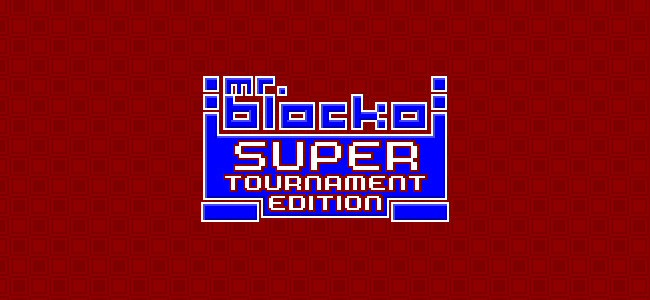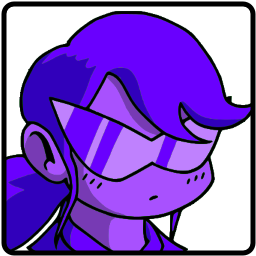Perfect Run, whatever happened to you? You guys made three games and then petered out. The last update on your website claimed that you were still alive and going strong… but that was 2008, and then the aether of the net reclaimed you, as it will some day do to us all.
Anyway, Mr. Blocko: Super Tournament Edition was, I believe, the third and final game released by the freeware indie game team Perfect Run, and it’s… interesting. Imagine a Tetris field. Now imagine that the pieces fall at random horizontal positions, and you cannot control where they land. Furthermore, once a piece lands, the blocks that comprise it separate, and, after a short delay, fall to the floor.
So how do you move the blocks? Indirectly. With one of these little creatures:
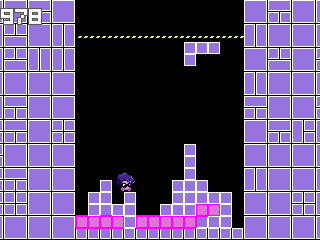
Oh look, it’s… me?
In the vein of a 2D platformer, you can run and jump around, pushing into blocks to move them. Pushing one block against another or even a full row of blocks will push them all, dropping them into crevices where possible. Your goal is, as in many falling blocks puzzles, to create a full row of blocks, which grants you points before disappearing. If the blocks stack up past the boundary line at the top, you lose.
Movement is actually pretty fast-paced, and getting around is not difficult at all. You even get six extra jumps while airborne, and the jumping physics are of the traditional sort, allowing you to easily move back and forth in the air while Newton’s exasperated ghost can only look on in disgust. If you’re wondering what happens when you inevitably get crushed by falling blocks, well, you don’t die. Instead, you fly up to the top of the screen, bouncing between the walls, and then descend, regaining full control when you land on a block (unless you immediately get squished by another block). If you push the left or right button, you can affect how much you do or don’t move in your current horizontal direction (think Super Smash Bros.). The game’s designer, Bisse, did a pretty good job of balancing this with the rest of the game because there’s a clear indication of when you’ll regain control, and you still have some ability to affect your trajectory, so you’re not completely at the mercy of the game.
In addition to the single player mode, there is a multiplayer mode. 2-4 people can play against each other in either a Time Limit, Score Limit, or No Limit (endless?!) mode. The gameplay is essentially the same, just with more chumps running amock, adding extra chaos.
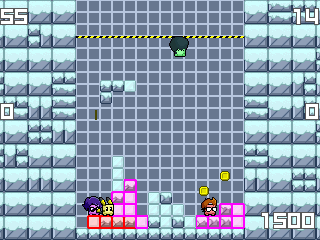
This shot was taken when I was playing alone, but hey, it works.
Now, you’ll finally see why pushed blocks become the colour of your character – they indicate who has control of the row. Once a player pushes a block into a row of blocks, all the blocks turn the colour of that player. The player who completes a row gains the points for it. If a player gets squashed by blocks or is stomped upon by an opponent, that player will lose points. There’s a special “coins” option that causes the injured player to hemorrhage coins while flying through the air; anyone may grab them in order to advance their own score.
I’ve only ever played the multiplayer mode with an actual human opponent once, and we played one round of Time Limit and one of Score Limit. I imagine that it might be more fun wtih four people running around, and perhaps even more fun with people who are actually into the game. Ah, well. This does bring me to one of the two problems I have with multiplayer, though, which is the fact that, unless I’m doing something incorrectly, it’s not possible to use gamepads for multiple people. So, in other words, if you did have four people playing at once, they’d all be on the keyboard. I suppose that programs such as Xpadder may be of some use here, but really, desktop games ought to have this option built into them by default.
My other, primary issue with the multiplayer mode is that it offers no AI opponents. I feel that AI is really important for just about any game that offers local multiplayer, especially PC games, as multiplayer modes often differ significantly from solo modes and thus offer further enjoyment of the game. In a game like this, it wouldn’t even be difficult to incorporate very basic opponents, not for the sake of providing intelligent and challenging rivals, but merely for the purpose of extending the game’s modes to accommodate solo players. I personally would have been fine with an opponent that simply followed the following rules:
- Move randomly about, chaotically jumping and pushing blocks.
- If it’s about to get squished by blocks, run to the nearest tile space that doesn’t have blocks directly above it.
- If an opponent is descending above it, move and try to evade being hit.
It’s simple, and kind of shitty, but it’s better than nothing, and it would have taken little-to-no effort to pull off. Sadly, multiplayer modes in most PC games end up being wholly unused by a large (or perhaps majority) proportion of their players. This is just another one of those cases in which it’s impossible to truly experience this unique mode without somehow conning somebody else into spending time with you.
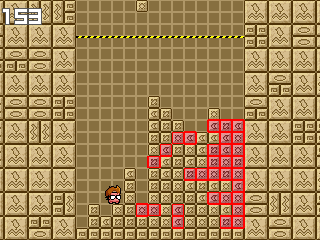
SurpriseEnema, apparently in the process of obsessively building an Egyptian cube.
As you may have noticed from the screenshots, characters are customizable. Mr. Blocko comes with a set of “accessories” (faces/hats for the characters) and “themes” (tile sets) that you can select from the menu. The graphics are quite cute and well-drawn, but if you have the knack and desire for it, you can open up the folders containing them and add your own graphics. I added in an accessory for myself and fellow TandemShocker SurpriseEnema, which you can download at the bottom of the article if you’re so inclined. The only weird thing about it is that you cannot save your settings for these things, so every time you start the game, you have to manually change these options again.
If you want an easier or tougher challenge or if you simply get bored with the game, you can also set a bunch of different options like field width, block speed, and the number of extra jumps, to name just a few. It adds a bit of replay value, though changing these options negates your ability to save a high score. High scores don’t really do anything special other than showing how badass you are, so maybe it’s not a problem for you.
Lastly, I cannot close this article without mentioning the music. The 9 tracks were composed by the talented Eirik Suhrke, also known as Phlogiston. He’s the same guy who went on to compose for Spelunky and Super Crate Box, among other titles. My personal favourite is a track called “Cham”, which I’ll probably be listening to for some time now that I’ve rediscovered it. I’m not sure why his BandCamp page doesn’t list this soundtrack (maybe he thought the loops are too short?), but if you have the right software, you can listen to them all you want since they’re just sitting in a folder next to the game.
Ultimately, Mr. Blocko: Super Tournament Edition is a cool and unique innovation of the classic falling blocks puzzle, a genre which is chock full of rehashes and slight variations, and that alone is enough for it to win my favour. It’s pretty lean on content, but for a first showing, it does what it needs to do. I imagine that this concept could be extended in subsequent titles and spun into something truly awesome, but I doubt that will ever happen. But, hey, if you’re a developer, maybe you could take this general concept and use it for something fresh and new. That kind of mindset is what we need in the industry.
Download Mr. Blocko: Super Tournament Edition
Download the TandemShock Mini-Addons Pack
